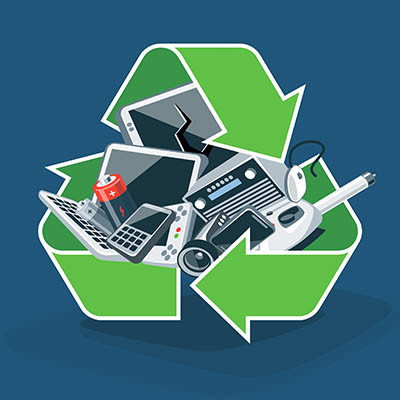BNMC Blog
Have a Professional Wipe Your Device Before Recycling It
No matter how new a device is, the unfortunate truth is that it will not last forever. Eventually, you will need to replace your device; the question then becomes what you do with your old technology. While you could just throw it in the trash, this is not only wasteful but also a security risk. In order to protect both your personal data and the environment, you must go through the proper channels to make sure that e-waste gets properly disposed of.
Let’s take a moment to look at what the process of discarding old devices looks like, as well as what is covered by the umbrella term of “e-waste.”
What Constitutes E-Waste?
In short, anything described as an electronic device can be considered e-waste if it were to become defunct. This includes computers and laptops, mobile devices, batteries, drives, monitors, and other consumer electronics such as air conditioners, televisions, kitchen appliances, radios, fans, and the like. None of this lasts forever, and while we could open up the conversation about product quality, that is a discussion for another day; the important thing to keep in mind is that projections from 2019 estimate that e-waste will exceed 52 million tons by the end of this year.
Most of these devices ultimately wind up in a landfill. According to recent data, only about 20 percent of e-waste is actually collected and recycled. You don’t need us to tell you that this is problematic.
Why E-Waste Must Be Recycled
There is a compelling argument for recycling e-waste compared to utilizing the “fresh” raw materials they are crafted from. These materials include the following metals:
- Iron
- Tin
- Aluminum
In addition to these more common metals, you have the precious metals:
- Titanium
- Gold
- Silver
And finally, there are the recyclable materials used in the making of components:
- Plastic
- Glass
It’s incredible how much can actually be extracted from devices, provided the recycling process is handled properly. Circuit boards, for example, contain materials like tin, copper, and other valuable metals like gold, silver, and palladium, all of which can be recycled and reused. Hard disks contain aluminum that can be reused when building automobiles. Even batteries can have their contents recovered and reused to create new batteries. It’s just one way that we can make sure that the efforts invested in creating these devices do not go to waste. Plus, it’s one way that we can help to make more jobs, as someone has to go about recycling these materials.
The real icing on the cake is that recycling e-waste keeps these hazardous materials from being tossed in a landfill, impacting the natural environment and doing much more harm than good.
The E-Waste Recycling Process
Since there are so many variables involved with recycling e-waste, such as the materials used and how they have been incorporated in the device in question, there is no “one size fits all” approach to it. That being said, the process generally includes each of the procedures outlined below.
Collection and Transportation
First, the electronics must be collected and transported to a recycling facility. This facility is responsible for processing the devices.
Disassembly and Dispensing
Next, the collected electronics are shredded, quite literally, into broken down pieces which are then sorted through by hand. There will be some variance here, as some products should not or cannot be broken down. They are also sorted out by type.
Dusting, Magnetic Separation, and Water Separation
The shreds of these devices are spread out and broken down even more. As you might assume, this process creates a ton of dust, which is then drawn out and safely discarded. Magnets and other methods are then applied to pull out the metallic elements (you know, the good stuff), and water separation is used to pull glass and plastics away from each other.
Purification
Leftover metals are removed from the plastic wastes to keep the waste stream as pure as possible.
Preparation and Resale
The final stage in the process is when the sorted materials are processed back into their raw state for reuse in the production of new devices, products, or components.
Think Before You Recycle!
If it’s time for you to upgrade to a new computer, laptop, or mobile device, it is imperative that you don’t forget to wipe it of its data. You can’t simply delete files or reinstall Windows. You want to make sure there is zero chance of any sensitive data being accessed or recovered from them. Old drives can contain files, and your computers or mobile devices can contain information such as your web history, passwords, and other personal information that could be used by hackers or other dishonest folk. It’s best to have a professional handle this process so that you can upgrade to a new device with confidence.
BNMC can help you perform this process! To get in touch, give us a call at (978) 482-2020. We’ll help you take all of the proper steps to recycle your e-waste in an environmentally-friendly and responsible way.




Comments